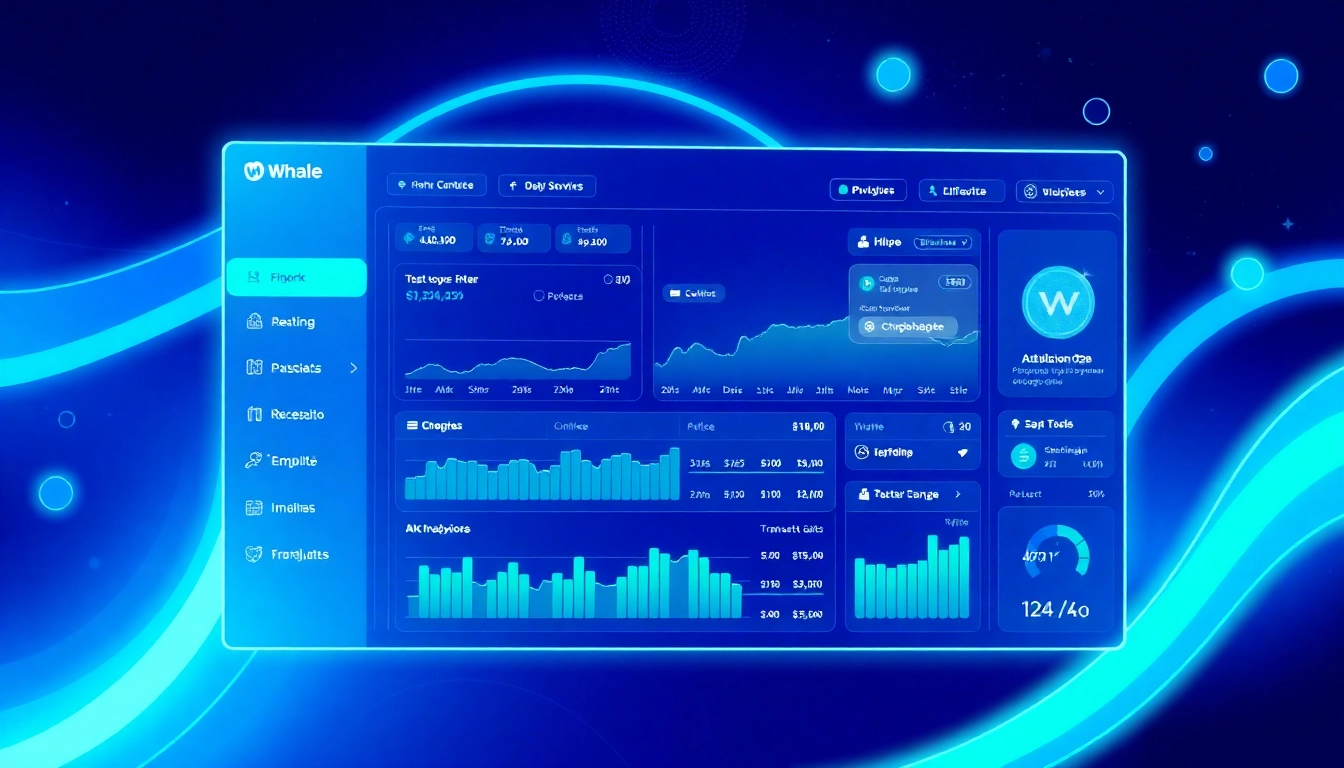Understanding the Whale Wallet Tracker
What is a Whale Wallet Tracker?
A Whale Wallet Tracker is a sophisticated tool designed to monitor the activities of large cryptocurrency holders, commonly referred to as “whales.” These whales typically control significant amounts of digital assets, and their buying or selling activities can heavily impact market prices. Essentially, a whale wallet tracker is akin to a financial radar, allowing investors to observe and analyze the transactions of influential wallet addresses in real-time. By utilizing tools like the whale wallet tracker, traders can gather insights into market trends and sentiment driven by these substantial entities.
Importance of Whale Tracking in Cryptocurrency
The cryptocurrency market is known for its volatility, which can sometimes be attributed to the trade actions of whales. Understanding their activities enables investors to anticipate potential market movements. Whale tracking provides an analytical edge by offering data that reflects the broader market sentiment; for example, if a whale is accumulating a particular asset, it could suggest bullish sentiment for that asset. Conversely, a mass selling might indicate pending bearish trends. Hence, whale trackers serve not just as tools for observation but also as key components in developing tactical trading strategies.
How Whale Wallets Influence Market Trends
Whale wallets can influence market trends significantly due to the sheer volume of assets they hold. For instance, a single trade from a whale can lead to sharp price fluctuations that can cascade through the market, affecting investors both directly and indirectly. Their influence isn’t just limited to the crypto they hold; the market reacts to the perceived intentions behind their transactions. Consequently, identifying and analyzing whale activity helps traders make informed decisions, navigate volatile markets adeptly, and potentially capitalize on favorable market conditions.
Key Features and Benefits of Whale Wallet Trackers
Real-Time Data Monitoring
One of the standout features of a whale wallet tracker is its capability to deliver real-time data monitoring. This feature allows users to keep tabs on significant wallet activities without delays, making it essential for timely decision-making. Through instant alerts on transactions, users can promptly assess whether to enter or exit trades based on credible market signals generated by whale activities. This immediacy can enhance an investor’s ability to capitalize on market movements, aligning their strategies with those of key market players.
Analyzing Whale Behavior Patterns
Whale behavior is not random; it often reveals strategic patterns driven by market analysis, investment goals, or sentiment shifts. Whale tracking tools analyze historical data to identify these patterns, which can provide valuable insights for traders. By understanding the buying habits and selling points of whales, investors can refine their trading strategies, align their portfolios, and optimize their exit strategies during sell-offs or rallies. Moreover, recognizing these behavioral trends equips investors to protect themselves against sudden market reversals.
Risk Management Through Whale Insights
Effective risk management is crucial in the trading landscape, and whale wallet trackers offer essential insights to mitigate risks. By keeping track of whale activities, traders can enhance their risk management strategies. For example, early detection of massive sell-offs can prompt traders to adjust their positions accordingly, thereby minimizing potential losses. Furthermore, tracking whale movements provides an added layer of security against market manipulation schemes, enabling traders to navigate the crypto markets with increased confidence.
Implementing a Whale Wallet Tracker in Your Strategy
Choosing the Right Tracker for Your Needs
With a variety of whale wallet tracking tools available, selecting the right one requires consideration of specific needs. Factors to weigh include user interface, data comprehensiveness, alert systems, and historical analytics features. It’s imperative to choose a tool that aligns with your trading strategies—whether you are looking for simplistic tracking for observation or advanced analytics for deeper insights. Researching and comparing different platforms through user reviews can significantly impact the effectiveness of your market strategies.
Setting Up and Using the Tracker Effectively
Once you’ve chosen a whale wallet tracker, setting it up correctly is paramount. Users should establish their notifications preferences based on the types of transactions they’re interested in—be it large purchases, transfers, or sell-offs. Effective use of the tracker includes regular analysis of whale activity reports, identifying patterns, and adjusting trading strategies in real-time based on alerts. Education on interpreting the data provided by the tracker also enhances its effectiveness—investors should not merely react but understand the implications of whale movements behind their trades.
Case Studies: Successful Whale Tracking Examples
Understanding real-world applications of whale wallet tracking can provide invaluable insights to investors. A notable example is the case of a prominent whale wallet that sold off a significant portion of Bitcoin, resulting in a sharp market dip. Traders utilizing a whale tracker identified the sell-off early, allowing them to exit their positions before experiencing losses. Another instance involved the accumulation of Ethereum by several whales, which signaled rising confidence in the asset, prompting savvy traders to invest before notable price increases ensued. Such case studies demonstrate the practical benefits of whale wallet tracking and its potential role in improving trading decision-making.
Common Challenges with Whale Wallet Tracking
Data Overload: Filtering Relevant Information
While whale tracking provides a wealth of data, an abundance of information can become overwhelming for traders. Sifting through large volumes of transactions may hinder effective decision-making. Implementing filters and focusing on specific wallet activities—like those from known influential wallets or high-value transactions—can help streamline this information. Having clear objectives for what whale activities are most relevant to your trading strategies can also minimize data overload, allowing for more targeted analyses.
Understanding False Positives
False positives represent a significant challenge in whale wallet tracking. Not every large transaction signifies a strengthening or weakening market sentiment; at times, transactions may involve strategic moves that do not impact the overall market. Consequently, it is crucial for traders to corroborate the data from whale trackers with overall market trends, news, and technical analysis. Developing analytical skills to discern between genuine signals and misleading data is integral to capitalizing on whale movements effectively.
Maintaining Trust in Whale Tracker Tools
Trust in whale tracker tools is paramount for effective trading. Traders must ensure that the platforms they select are credible and provide accurate, real-time data. Regular updates, system transparency, and user feedback contribute to the reliability of these tools. Therefore, continually assessing the platform’s performance and seeking user testimonials can help maintain confidence in the information being provided. Unscrupulous data can lead to misguided trades and substantial financial losses, emphasizing the need for diligence when using such tracking tools.
Future Trends in Whale Wallet Tracking
Upcoming Technologies Impacting Whale Tracking
The future of whale wallet tracking is promising, with various emerging technologies poised to enhance their effectiveness. Innovations such as blockchain analytics will improve the accuracy of transaction tracking and wallet identification. The integration of advanced modeling algorithms will allow better prediction of market shifts based on whale behavior. Furthermore, tracking platforms may begin incorporating visualized data representation tools to provide clearer insights, improving the overall user experience.
Integrating AI with Whale Wallet Trackers
Artificial intelligence (AI) holds significant transformative potential for whale wallet tracking. Machine learning algorithms can analyze historical transaction data, helping to predict future movements and identify emerging trends that traditional methodologies may overlook. Predictive analytics enabled by AI could enhance the efficiency of risk management strategies and inform trading decisions with increased confidence. The combination of AI technology with whale tracking is likely to streamline data interpretation, providing traders with sharper insights and proactive strategies against market volatility.
Predictions for Market Dynamics and Whale Behavior
Anticipating how market dynamics will evolve based on whale behavior remains a subject of great interest. As mainstream adoption of cryptocurrencies continues to grow, the size and significance of whale transactions will likely expand. This evolution could lead to increased interactions between whales and average investors, highlighting the need for sophisticated tracking tools that adapt accordingly. In the future, traders will likely see a more intricate web of market movements influenced by a mix of individual and institutional behaviors, reinforcing the critical role of whale tracking in effective trading strategies.















Leave a Reply